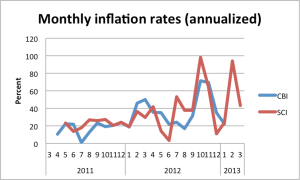By Djavad Salehi.
The statistics most readily available for Iran are about prices, yet they are seen as the least believable. Last week the Statistical Center of Iran that reports on unemployment, household budget and national income, and now claims to be the official source for reporting on inflation, published a report providing us with detailed information on prices for the last six years (2007-2013). It shows that the consumer price index (CPI) rose by 40.6% during the Iranian year 1391 (21 March 2012 to 20 March 2013), and the average index for 1391 was 31.5% above 1390.
The former is the point to point inflation, what people feel, and the other is what is officially reported as the years’ inflation. Until now, Iran’s Central Bank was the official source for inflation reporting, but for the last several months it has not published any numbers and recently one can only see press reports of its numbers. The last number I have is for Dey 1391 (January 2013). I was curious how closely the two indices (both for urban areas) follow each other, so I put together a couple of graphs which show not all that closely. I have put both series on a common base with 2002=100. The two annual series closely follow each other until 2010 but diverge significantly thereafter. According the Central Bank of Iran (CBI) data, prices are up 100% since 2010, but 129% according to the Statistical Center (SCI).
Monthly figures show a few divergences here and there, which are hard to understand. For example, in July 2011, according to the SCI index prices rose at a 20% annual rate, whereas according to CBI they hardly increased at all. The most interesting part of the SCI numbers are for the last two months of the Iranian year that just ended, when CBI numbers is silent, and they show a sharp increase in prices during February (94% annual rate), coming down to 43% annual rate in march. These price increases are likely affected by the pre-Nowruz shopping, but they also indicate that the Central Bank is still not fully in control of the money supply.

The die-hard critics of Iran’s official inflation data are not likely to be satisfied by the release of these numbers. People have their own experiences of prices based on what they buy and a national basket will hardly satisfy everyone. Both CBI and SCI data show that prices for food and medical services on which lower income families depend more heavily have far outpaced other items.
The producers of these data can win greater public trust by publishing more details, such as CPI by region and by decile of income. Such numbers will very likely show that in recent years the poor have experienced greater inflation because of the much higher share of food in their baskets (about 35% for the lowest decile compared to about 20% for the highest decile). Regional price levels would also help with measurement of poverty, which is very sensitive to variation in the cost of living by location.
Each month, the SCI samples the prices of about 460 items in stores nationally and the incomes and expenditures of more than 2000 households. It can produce much more detailed information if it wants to. Even that might not be enough to stop the so-called experts who keep repeating the same old mantra to the Western press, that actual inflation is twice what it really is. For an example, see this article in the New York Times earlier this week, which claims that the doubling is because Iranian statisticians do not include the price of imported goods in the index (really?).
Claims that actual inflation is double the official rate is nothing new. As I have said before, people who make such claims do not know their math. If you were to double the official inflation rate for the last 7 years of data that I have reproduced here, from 2007-2012, prices in early 2013 would be 10 times as high as in 2007, compared to 3 times according to official figures. It is easy to see how silly it is to keep saying inflation is twice what official figures say because if you back out prices in 2007 from current prices using expert advice you will get silly numbers.
For example, a cab ride from the airport to downtown Tehran which today cost about 350,000 rials ($10 with the free market price of USD), according to the expert figures would have cost 35000 rials ($3.50 at 10,000 exchange rate prevailing then), which is no one’s recollection. Or a hamburger that today cost about 50,000 rials would have cost 5000 rials instead of 15000 rials, which is much closer to reality. Inflation figures are not like unemployment rates, which you can fake for a while and get away with it if the economy improves.
The price level is there for everyone to see and will have implications long after a particular inflation episode has passed. Running a state and an economy with fake numbers is more difficult than the experts who advise Western media seem to think — unless it is all politics masquerading as expert advice!



